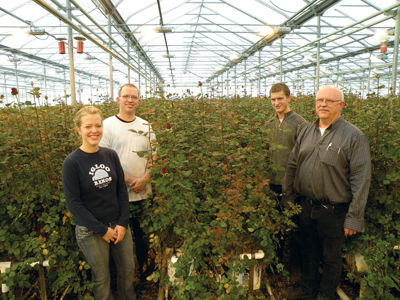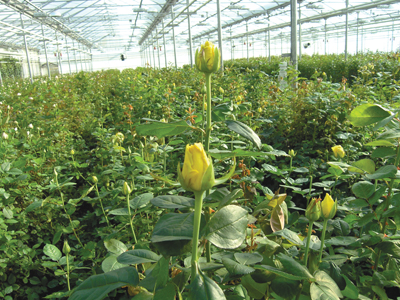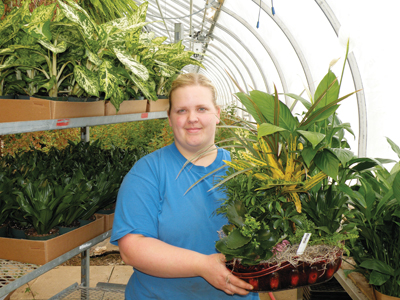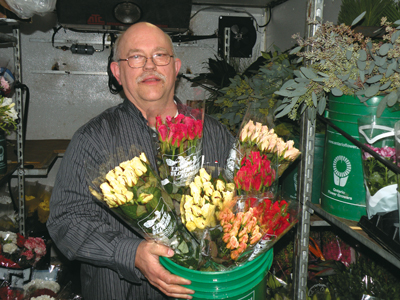
Cleopatra was said to have filled rooms knee deep in rose petals. And while not everyone takes their fondness for this flower to the same extreme, the rose remains one of the world’s favourite flowers.

|
| Monique, Scott, Ben and John Lindeboom.
|
Cleopatra was said to have filled rooms knee deep in rose petals. And while not everyone takes their fondness for this flower to the same extreme, the rose remains one of the world’s favourite flowers.
The Greek poetess, Sappho, referred to it as the “Queen of Flowers” back in 600 BC, in her “Ode to the Rose.” It’s a reference that continues to this day.
This symbol of love has been widely celebrated in literature. Shakespeare, for one, referred to roses more than 50 times throughout his writings. (“What’s in a name? That which we call a rose, by any other name would smell as sweet.”)
It’s a Valentine’s Day staple, and a favourite anniversary gift. In the U.S., National Rose Month has been celebrated for more than 30 years each June.
And at Lindy’s Flowers of Dunnville, Ontario, you’ll find rows and rows of roses, some 23 varieties spread throughout 84,000 square feet of production space.
The Lindeboom family sure knows roses.

|
|
| Lindy’s Flowers has 23 varieties of roses | |

|
|
| Rebecca Snippe is the company’s dish garden designer. She’s been with the company for 10 years. | |

|
|
| John Lindeboom drives one of two company wholesaling delivery trucks.
|
LINDY’S BEGAN WITH CUT MUMS
John and Wilma Lindeboom launched Lindy’s Flowers in a 10,000-square-foot greenhouse in July of 1980. For the first five years, they grew cut mums before switching to roses in 1985. “We knew there was a market for cut mums,” John explains, “and I had an uncle who was able to teach me more about the crop.”
The transition into roses was done gradually, two bays at a time. John learned to grow roses from a nearby friend. “We were only out of production for about two weeks in total,” recalls John.
Lindy’s Flowers is primarily known for both long stem and sweetheart roses. In addition, and as part of their wholesaling operations, they also source locally grown flowers for their own line of eye-catching dish gardens. These are prepared for a growing customer base.
Sons Scott (in 1998) and Ben (in 2003) have since joined the business. The two share the growing responsibilities. In addition, Scott handles the overall sales, while Ben takes care of maintenance. John drives one of two company delivery trucks three days a week and Wilma oversees much of the office administrative work.
The family-owned business has steadily grown over the years to its current size of 84,000 square feet. They have four full-time employees, five part-timers, and eight students who come in on Saturdays.
COCONUT SUBSTRATE SINCE ’95
The Lindebooms initially grew in the soil. The land was good for roses, though the pH levels had to be continually adjusted. By 1995, they began moving out of soil and into coconut substrate, a product that was, at that time, relatively new to the industry. “It’s always worked well for us,” says John, noting coco holds nutrients extremely well and doesn’t break down.
Lindy’s Flowers first utilized forced air heaters, before investing in a steam boiler in 1981. That unit held up well until 2006 when it was replaced with a hot water system. “The steam system was getting a little old,” says Scott, “and the hot water allows for heat storage.”
The Lindebooms have been burning alternative fuels since 2006 to control energy costs. “We’re still on a learning curve,” says Ben. They had issues with oat hulls and then coal, but are finding greater success with wood pellets.
The unit isn’t yet working as effectively as they had hoped. The mechanics of the system are fine. However, consistency with the fuel supply can be an issue, especially if there’s too much sawdust in the mix.
About 20 to 25 per cent of the rose crop is renewed each year. Production and quality usually go down after five years, and the plants are replaced.
VARIETIES MORE PRODUCTIVE
The new rose varieties are much more productive. Breeders have boosted yields from a little over 250 stems per square metre a few years ago to some 300 to 350 stems per square metre. “There’s great breeding work being done,” notes Scott.
Among challenges over the years was a major ice storm in 1991, which knocked out power in the region. Thankfully, John was able to coax an old generator to fill in. “I had to beg it to start,” he quips, “and we had to keep it running for three days.”
Ben says they keep a close watch for spider mites, thrips and powdery mildew. Canker can be an issue with some of the older varieties. They prefer to use biocontrols, with bio-friendly chemical treatments only applied to hot spots. “You can’t let problems get out of hand,” Scott explains. “We definitely see biocontrols as a way of the future.”
With their latest expansion completed in 2007, the Lindebooms are happy with the size of their greenhouses. But they’re not standing pat. The irrigation pond was expanded last year, doubling its size. They’re always looking for new and innovative ideas to achieve better savings and efficiencies.
Ontario’s cut flower industry has been shrinking, and roses reflect the trend.
“There aren’t as many rose growers as there used to be,” says Scott. “They’ve gone into snaps, alstroemeria and gerbera.”
According to StatsCanada, rose production has dropped from 43.7 million stems in 1997 in Ontario (62.3 million across Canada), to 13.5 million in 2007 (23.8 million Canada-wide). Imports have made major inroads.
DEMAND FOR ROSES IS CYCLICAL
“We have maintained a niche market in southwestern Ontario,” says Scott, “with most of our sales to other wholesalers.” Demand for roses is cyclical, “but we’re fairly optimistic.” Sales have been steady of late, he adds.
Lindy’s Flowers bought into the Pick Ontario program early and have been quite impressed with this marketing initiative of Flowers Canada (Ontario). (See our March 2009 issue, pg. 20)
Consumers are increasingly supporting locally grown products. The initiative began with food and the 100-Mile Diet.
Flowers are a perfect fit. Just two days after being harvested, they’re already in flower shops or homes, unlike South American imports that can be in transit for several days.
“Freshness is our advantage,” says Scott. “It’s a major advantage.”
Print this page